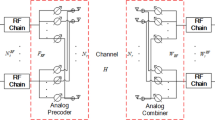Abstract
In order to improve the spectral efficiency of hybridly-connected hybrid precoding, the optimal hybrid precoding matrix under the ideal conditions was firstly obtained by using the principle of successive interference cancellation. Secondly, the optimal hybrid precoding matrix was decomposed into the digital precoding matrix and the analog precoding matrix by using the gradient descent theory. Finally, considering the constant modulus constraint condition of the analog precoding matrix, the digital and analog precoding matrices were optimized by using the alternating minimization method aim to maximize the spectral efficiency. Due to the hybridly-connected structure, the proposed hybrid precoding design algorithm is significantly superior to the partially-connected and fully-connected hybrid precoding in terms of the system energy efficiency. Meanwhile, the algorithm does not increase any hardware complexity and only increases a small amount of computation of the hybrid-connected hybrid precoding.






Similar content being viewed by others
Data Availability
Data sharing not applicable to this article as no datasets were generated during the current study.
Code Availability
Software application.
References
El Ayach, O., et al. (2014). Spatially sparse precoding in millimeter wave MIMO systems. IEEE Transactions on Wireless Communications, 13(3), 1499–1513.
Zhang, D., et al. (2018). SVD-based low-complexity hybrid precoding for millimeter-wave MIMO systems. IEEE Communications Letters, 22(10), 2176–2179.
Li, N., et al. (2017). Hybrid precoding for mmWave massive MIMO systems with partially connected structure. IEEE Access, 5, 15142–15151.
Hu, C.-C., & Zhang, J.-H. (2018). Hybrid precoding design for adaptive subconnected structures in millimeter-wave MIMO systems. IEEE Systems Journal, 13(1), 137–146.
Yu, X., et al. (2015). Hybrid precoding design in millimeter wave MIMO systems: An alternating minimization approach. In 2015 IEEE global communications conference (GLOBECOM). IEEE.
Huang, H., et al. (2019). Deep-learning-based millimeter-wave massive MIMO for hybrid precoding. IEEE Transactions on Vehicular Technology, 68(3), 3027–3032.
Zhao, J., et al. (2017). Angle domain hybrid precoding and channel tracking for millimeter wave massive MIMO systems. IEEE Transactions on Wireless Communications, 16(10), 6868–6880.
Zhang, D., et al. (2017). Hybridly connected structure for hybrid beamforming in mmWave massive MIMO systems. IEEE Transactions on Communications, 66(2), 662–674.
Yu, X., et al. (2016). Alternating minimization algorithms for hybrid precoding in millimeter wave MIMO systems. IEEE Journal of Selected Topics in Signal Processing, 10(3), 485–500.
Lu, Y., et al. (2019). Improved hybrid precoding scheme for mmWave large-scale MIMO systems. IEEE Access, 7, 12027–12034.
Ghauch, H., et al. (2015). Subspace estimation and decomposition for hybrid analog-digital millimetre-wave MIMO systems. In 2015 IEEE 16th international workshop on signal processing advances in wireless communications (SPAWC). IEEE.
Jindal, N. (2006). MIMO broadcast channels with finite-rate feedback. IEEE Transactions on Information Theory, 52(11), 5045–5060.
Rusek, F., et al. (2012). Scaling up MIMO: Opportunities and challenges with very large arrays. IEEE Signal Processing Magazine, 30(1), 40–60.
Eckart, C., & Young, G. (1936). The approximation of one matrix by another of lower rank. Psychometrika, 1(3), 211–218.
Abdi, H., & Williams, L. J. (2010). Principal component analysis. Wiley Interdisciplinary Reviews: Computational Statistics, 2(4), 433–459.
Gao, X., Dai, L., & Sayeed, A. M. (2018). Low RF-complexity technologies to enable millimeter-wave MIMO with large antenna array for 5G wireless communications. IEEE Communications Magazine, 56(4), 211–217.
Park, S., Alkhateeb, A., & Heath, R. W. (2017). Dynamic subarrays for hybrid precoding in wideband mmWave MIMO systems. IEEE Transactions on Wireless Communications, 16(5), 2907–2920.
Hemadeh, I. A., Satyanarayana, K., El-Hajjar, M., & Hanzo, L. (2017). Millimeter-wave communications: Physical channel models, design considerations, antenna constructions, and link-budget. IEEE Communications Surveys & Tutorials, 20(2), 870–913.
Funding
The authors received no financial support for the research work.
Author information
Authors and Affiliations
Corresponding author
Ethics declarations
Conflict of interests
The authors declare that they have no conflict of interest.
Additional information
Publisher's Note
Springer Nature remains neutral with regard to jurisdictional claims in published maps and institutional affiliations.
Rights and permissions
About this article
Cite this article
Thurpati, S., Muthuchidambaranathan, P. Design of Hybrid Precoding for Millimeter-Wave Massive MIMO System. Wireless Pers Commun 127, 3363–3377 (2022). https://doi.org/10.1007/s11277-022-09922-5
Accepted:
Published:
Issue Date:
DOI: https://doi.org/10.1007/s11277-022-09922-5




